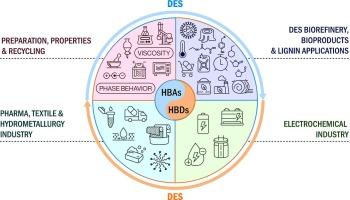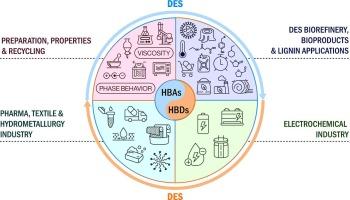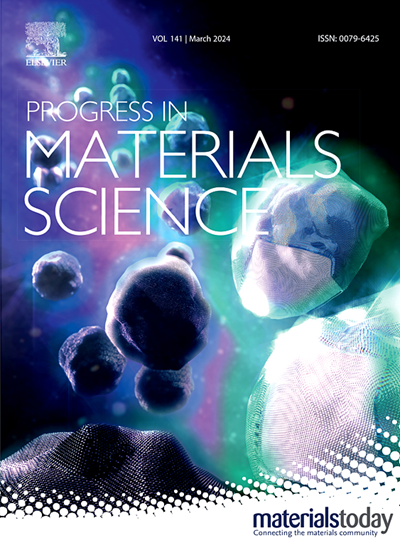深共晶溶剂(DES)的出现:化学、制备、性质及其在生物精炼厂和关键材料中的应用
IF 40
1区 材料科学
Q1 MATERIALS SCIENCE, MULTIDISCIPLINARY
引用次数: 0
摘要
可再生的深共晶溶剂(DES)作为清洁高效的催化剂和溶剂的出现,为木质纤维素生物炼制和关键材料行业,包括化学、能源、制药、纺织和湿法冶金行业创造了新的机遇。本文从DES的化学性质、分类、制备方法、加工特点、可回收性等方面对其进行了综述,重点介绍了DES的独特属性和行业应用。重点是将DES整合到先进的生物精炼系统中,重点是其可调的物理化学和热力学特性,用于生物质预处理和增值产品的生产。这篇综述探讨了如何将DES用于选择性溶解生物质成分,并评估了DES衍生生化物质的生产和增值,重点是木质素提取机制和生物质转化为生物产品和生物燃料。除生物精炼厂外,其应用范围还扩展到电化学能源设备中的DES应用,在这些设备中,DES用作电解质、电极材料的合成介质和电池回收中的浸出剂。还探讨了DES在制药、湿法冶金和纺织部门的多功能作用,以促进可持续加工。最后,该综述确定了未来的研究方向,概述了工业持续发展的好处、挑战和知识差距本文章由计算机程序翻译,如有差异,请以英文原文为准。


Emergence of deep eutectic solvents (DES): chemistry, preparation, properties, and applications in biorefineries and critical materials
The emergence of renewable deep eutectic solvents (DES) as clean and efficient catalysts and solvents has created new opportunities for lignocellulosic biorefineries and critical material sectors, including chemical, energy, pharmaceutical, textile, and hydrometallurgical industries. This review provides an in-depth overview of DES, covering their chemistry, classifications, preparation methods, processing characteristics, and recyclability, while highlighting their unique attributes and industry relevant applications. Emphasis is placed on the integration of DES into advanced biorefinery systems, focusing on their tunable physicochemical and thermodynamic properties for biomass pretreatment and the production of value-added products. The review explores how DES can be tuned for selective dissolution of biomass components and evaluates production and valorization of DES-derived biochemicals, with attention to lignin extraction mechanisms and conversion of biomass into bioproducts and biofuels. Beyond biorefineries, the scope extends to DES applications in electrochemical energy devices, where they serve as electrolytes, synthesis media for electrode materials, and leaching agents in battery recycling. The multifunctional roles of DES in pharmaceutical, hydrometallurgical, and textile sectors are also explored for contributions to sustainable processing. Finally, the review identifies future research directions, outlining benefits, challenges, and knowledge gaps, for continued industrial development.
求助全文
通过发布文献求助,成功后即可免费获取论文全文。
去求助
来源期刊

Progress in Materials Science
工程技术-材料科学:综合
CiteScore
59.60
自引率
0.80%
发文量
101
审稿时长
11.4 months
期刊介绍:
Progress in Materials Science is a journal that publishes authoritative and critical reviews of recent advances in the science of materials. The focus of the journal is on the fundamental aspects of materials science, particularly those concerning microstructure and nanostructure and their relationship to properties. Emphasis is also placed on the thermodynamics, kinetics, mechanisms, and modeling of processes within materials, as well as the understanding of material properties in engineering and other applications.
The journal welcomes reviews from authors who are active leaders in the field of materials science and have a strong scientific track record. Materials of interest include metallic, ceramic, polymeric, biological, medical, and composite materials in all forms.
Manuscripts submitted to Progress in Materials Science are generally longer than those found in other research journals. While the focus is on invited reviews, interested authors may submit a proposal for consideration. Non-invited manuscripts are required to be preceded by the submission of a proposal. Authors publishing in Progress in Materials Science have the option to publish their research via subscription or open access. Open access publication requires the author or research funder to meet a publication fee (APC).
Abstracting and indexing services for Progress in Materials Science include Current Contents, Science Citation Index Expanded, Materials Science Citation Index, Chemical Abstracts, Engineering Index, INSPEC, and Scopus.
 求助内容:
求助内容: 应助结果提醒方式:
应助结果提醒方式:


